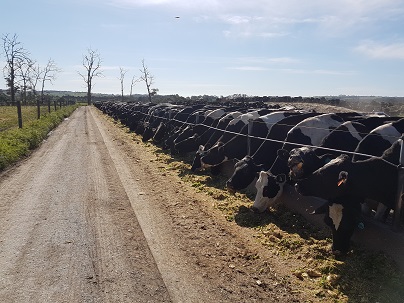24hr Digestibility – A Key to Profit

Rate-of-passage is a very important concept for both cow health, and especially, feed conversion efficiency – feed dollars to milk dollars. It is also a tension, that is, too fast from very lush pasture or sub-optimal rumen pH, will reduce feed conversion efficiency and increase feed cost per litre significantly, not to mention cow health. Our valuable feed ends up in manure pats in the paddock instead of milk in the vat. Alternately, high fibre feeds such as poor quality/mature silage or hay, will slow down rate-of-passage of feed through the digestive tract, reducing daily feed intake and crashing milk production. In both cases, the feed cost per litre will escalate.
The starting point is always cows’ access to sufficient feed to be fully fed. Then there are two states of being ‘fully fed’. Full to contentment, and physically gut fill. Obviously physical gut fill is the goal of optimum milk production, reduced cost per litre from dilution of maintenance energy cost, and maximised profit which usually is accompanied by cow health.
Assuming cows do have access to sufficient feed, which is not common outside spring, the next limitation is palatability. Feed, be it pasture, summer crops, silage, grain or anything else, must first be highly palatable to achieve potential feed intake. Now back to rate-of-passage.
High fibre feeds spend long periods in the rumen being broken down sufficiently to pass into the abomasum, the true stomach. This reduces rate-of-passage to the extent that feed intake is also reduced with consequent reduction in milk production, higher feed cost per litre, as above, maintenance energy cost per litre, all culminating, and by a multiplier effect, in a crash in profit.
Feed NDF% (Neutral Detergent Fibre – total fibre in any given feed or ration), really does not tell us much as far as predicting milk production and profit from this feed or ration. Digestibility is the key.
Good feed analysis laboratories will supply 24 hr, 30 hr and 240 hr digestibility rates for feeds submitted for testing. Although there is some debate among academics as to which, 24 or 30 hr digestibility rates, are best to predict milk outcomes, my simplistic understanding prefers the 24 hr digestibility data. Why? Because we all work on 24 hr milk production systems to inform us as to how we are producing.
The 24 hr digestibility is telling us how much fibre is still in the rumen from yesterday, and how much that is going to reduce our cow’s feed intake today; and her milk production/profit.
Let’s look at two examples of pasture from our feed test library: 1) Actively growing/short rotation ryegrass – 24 hr digestibility 81.48%, sampled in June 17. 2) Slow growing/long rotation ryegrass – 24 hr digestibility 51.73%, sampled in November 16.
If we fed 10 kgs DM (dry matter) of each pasture to two groups of cows the difference in ryegrass digested and converted to milk would be 1) 8.148 kgs DM, 2) 5.173 kgs DM. Now, to compound the issue, the quality pasture has an ME (energy value) of 10.26 MJME/kg DM. The mature ryegrass has an ME of 9.18 MJME/kg DM.
Now, our cows digesting 8.148 kgs DM of the quality 10 kg DM pasture would convert that to 14.9 lts of milk. The cows consuming 10 kgs DM of the mature pasture and digesting only 5.173 kgs DM would convert that to 8.48 litres of milk. There is $1.57 difference in milk production at 40c/lt between each group of cows! Essentially, $1.57 difference in profit.
The plot thickens: The group of cows consuming the quality pasture will have 1.852 kgs DM fibre still in their rumens tomorrow reducing their feed intake for tomorrow and limiting tomorrow’s milk production by 3.39 lts. The cows consuming the mature pasture will have 4.827 kgs DM fibre remaining in their rumens tomorrow. This reduces their feed intake tomorrow and reduces milk production by 7.91 lts.
Yes this is an extreme example for the purpose of highlighting the influence of 24 hr digestibility, as no forage fibre is 100% digestible in 24 hrs. The lesson stands nevertheless, and has devastating impacts on farm profit from not managing grazing particularly, but even worse, time/maturity stage of cutting pasture for silage’s impact on 24 hr digestibility. We have silage test data on hand with variations in 24 hr digestibility between 77% and 49%.
The Remedies
Pasture: Short rotations of actively growing and regularly re-pastured stands. This is easily done with strategic fertilizer applications and produces healthy plants. Healthy pasture plants then produce healthy soils, there is a synergy here between these two, but it starts with healthy and actively growing plants. A system proven to achieve this is light applications of a complete blend after every grazing – 21 days. Fertilizer can be reduced once soils are health and vital. Fertilizer is always the cheapest feed!
Silage: As above, maturity at cutting is number one. Time between cutting and ensiling is number two (see our article ‘Silage in a Day’ sept 15). Third is a quality lactic acid bacterial silage inoculant containing a proven enzyme pack. Enzymes will break down indigestible fibre converting it to sugars for lactic acid producing bacteria to convert to lactic acid – high palatability/silage intake. This reduction in indigestible fibre will increase 24 hr digestibility and milk production from each kg DM of silage.